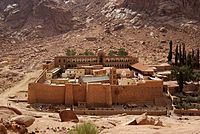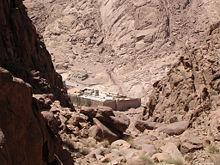- Mount Sinai
-
For the Biblical Mount Sinai, and a discussion of its possible locations, see Biblical Mount Sinai.For other places with the same name, see Mount Sinai (disambiguation).
Mount Sinai 
View from the summit of Mount SinaiElevation 2,285 m (7,497 ft) Location Location Saint Catherine, South Sinai Governorate, Egypt Coordinates 28°32′23″N 33°58′24″E / 28.53972°N 33.97333°ECoordinates: 28°32′23″N 33°58′24″E / 28.53972°N 33.97333°E  Sinai Peninsula, showing location of Mount Sinai
Sinai Peninsula, showing location of Mount Sinai
Mount Sinai (Hebrew: הר סיני Har Sinai) (Arabic: طور سيناء Ṭūr Sīnā’ or جبل موسى Jabal Mūsá), also known as Mount Horeb, Mount Musa, Gabal Musa (Egyptian Arabic), Jabal Musa (standard Arabic) meaning "Moses' Mountain", is a mountain near Saint Catherine in the Sinai Peninsula of Egypt. A mountain called Mount Sinai is mentioned many times in the Book of Exodus in the Torah and the Bible[1] as well as the Quran.[2] According to Jewish, Christian and Islamic tradition, the biblical Mount Sinai was the place where Moses received the Ten Commandments.
Contents
Geography
Mount Sinai is a 2,285-metre (7,497 ft) high mountain near Saint Catherine in the Sinai region. It is next to Mount St. Catherine (at 2,629 m/8,625 ft, the tallest peak on the Sinai peninsula).[3] It is surrounded on all sides by higher peaks of the mountain range.
Geology
Mount Sinai's rocks were formed in the late stage of the Arabian-Nubian Shield's (ANS) evolution. Mount Sinai displays a ring complex that consists of alkaline granites intruded into diverse rock types, including volcanics. The granites range in composition from syenogranite to alkali feldspar granite. The volcanic rocks are alkaline to peralkaline and they are represented by subaerial flows and eruptions and subvolcanic porphyry. Generally, the nature of the exposed rocks in Mount Sinai indicates that they originated from different depths.
Religious significance
 A small Mosque at the top of Mount Sinai
A small Mosque at the top of Mount Sinai Main articles: Biblical Mount Sinai and Saint Catherine's Monastery, Mount Sinai
Main articles: Biblical Mount Sinai and Saint Catherine's Monastery, Mount SinaiThe biblical Mount Sinai was one of the most important sacred places in the Abrahamic religions.
According to Bedouin tradition, it was the mountain where God gave laws to the Israelites. However, the earliest Christian traditions place this event at the nearby Mount Serbal, at the foot of which a monastery was founded in the 4th century; it was only in the 6th century that the monastery moved to the foot of Mount Catherine, following the guidance of Josephus's earlier claim that Sinai was the highest mountain in the area. Jebel Musa, which is adjacent to Mount Catherine, was equated with Sinai, by Christians, only after the 15th century.
Christian orthodoxies settled upon this mountain in the third century, Georgians from the Caucasus moved to the Sinai Peninsula in the fifth century, and a Georgian colony was formed there in the ninth century. Georgians erected their own temples in the area of the modern Mount Sinai. The construction of one such temple was connected with the name of David The Builder, who contributed to the erecting of temples in Georgia and abroad as well. There were political, cultural and religious motives for locating the temple on Mount Sinai. Georgian monks living there were deeply connected with their motherland. The temple had its own plots[clarification needed] in Kartli. Some of the Georgian manuscripts of Sinai remain there, but others are kept in Tbilisi, St. Petersburg, Prague, New York, Paris and in private collections.
Some modern biblical scholars now believe that the Israelites would have crossed the Sinai peninsula in a direct route, rather than detouring to the southern tip (assuming that they did not cross the eastern branch of the Red Sea/Reed Sea in boats or on a sandbar), and therefore look for the biblical Mount Sinai elsewhere.
The Song of Deborah, which some textual scholars consider to be one of the oldest parts of the bible, suggests that Yahweh dwelt at Mount Seir, so many scholars favour a location in Nabatea (modern Arabia). Alternatively, the biblical descriptions of Sinai can be interpreted as describing a volcano, and so a small number of scholars have considered equating Sinai with locations in northwestern Saudi Arabia; there are no volcanoes in the Sinai Peninsula.
Saint Catherine Area * UNESCO World Heritage Site
Country Egypt Type Cultural Criteria i, iii, iv, vi Reference 954 Region ** Arab States Inscription history Inscription 2002 (26th Session) * Name as inscribed on World Heritage List
** Region as classified by UNESCOSt. Catherine's Monastery
(Greek: Μονὴ τῆς Ἁγίας Αἰκατερίνης) lies on the Sinai Peninsula, at the mouth of an inaccessible gorge at the foot of modern Mount Sinai in St. Catherine city in Egypt at an elevation of 1550 meters. The monastery is Greek Orthodox and is a UNESCO World Heritage Site. According to the UNESCO report (60100 ha / Ref: 954) and website hereunder, this monastery has been called the oldest working Christian monastery in the world – although the Monastery of Saint Anthony, situated across the Red Sea in the desert south of Cairo, also lays claim to that title.
Discovery of ancient unknown script – Caucasian Albanian
A devastating fire in 1971 at St. Catherine's Monastery on Mt. Sinai led to the discovery of 1100 manuscripts that had been kept in a crypt below the chapel floor but which had been totally forgotten until they were accidentally discovered during reconstruction of the chapel in 1975.[4][5] The most significant discovery was a palimpsest manuscript which had Georgian script on the visible layer but an unknown script, which was barely visible on the underlying layer and which turned out to be an ancient Caucasian Albanian text.
In 1990, Dr. Zaza Aleksidze, Director of the Center for Manuscripts in Tbilisi, Georgia, discovered the unknown script. In 1996, he identified it as Caucasian Albanian, a script which has 52 letters based on Georgian, Ethiopian, and Armenian alphabets. The script described a language in the Caucasus that was the ancestor to the language spoken by the present-day Udis, who live in three villages in Azerbaijan and Georgia.[6]
In 2001, Aleksidze was able to decipher his first word – "Thesalonike," referring to passages in the New Testament that St. Paul addressed to the Thessalonians.[7] and he later identified the text of some 300 pages as one of the earliest existing Lectionaries in the Christian religion (5th–6th centuries).[8]
Ascent
There are two principal routes to the summit. The longer and shallower route, Siket El Bashait, takes about 2.5 hours on foot, though camels can be used. The steeper, more direct route (Siket Sayidna Musa) is up the 3,750 "steps of penitence" in the ravine behind the monastery.[9]
Summit
The summit of the mountain has a mosque that is still used by Muslims. It also has a Greek Orthodox chapel, constructed in 1934 on the ruins of a 16th century church, that is not open to the public. The chapel encloses the rock which is considered to be the source for the biblical Tablets of Stone.[10] At the summit also is "Moses' cave", where Moses was said to have waited to receive the Ten Commandments.
See also
- Saint Katherine city
- Archaeology
- Mount Gerizim
- Jebel Musa, Morocco, a similarly named mountain in Morocco
- Jabal al-Lawz
- Biblical Mount Sinai
Notes
- ^ Joseph J. Hobbs, Mount Sinai (University of Texas Press) 1995, discusses Mount Sinai as geography, history, ethnology and religion.
- ^ "Tafsir Ibn Kathir". Tafsir.com. 2002-10-26. http://www.tafsir.com/default.asp?sid=95&tid=58726. Retrieved 2011-03-21.
- ^ "Sinai Geology". AllSinai.info. http://www.allsinai.info/sites/geology.htm.
- ^ Zaza Aleksidze and Jean-Pierre Mahé, "The Rediscovery of the Albanian Script in Introduction: The Caucasian Albanian Palimpsests of Mt. Sinai (Brepols, 2008), Vol. 1, p. xx.
- ^ Zaza Aleksidze and Betty Blair, "Caucasian Albanian Alphabet: Ancient Script Discovered in the Ashes," in Azerbaijan International, Vol. 11:3 (Autumn 2003), pp. 38–41.
- ^ Zaza Aleksidze and Betty Blair, "Caucasian Albanian Alphabet: Ancient Script Discovered in the Ashes," in Azerbaijan International, Vol. 11:3 (Autumn 2003), pp. 38–41.
- ^ Zaza Aleksidze and Betty Blair, "The Albanian Script: The Process – How Its Secrets Were Revealed," in Azerbaijan International, Vol. 11:3 (Autumn 2003), pp. 44–51.
- ^ Zaza Aleksidze and Betty Blair, "Quick Facts: Caucasian Albanian Script," in Azerbaijan International, Vol. 11:3 (Autumn 2003), p. 43.
- ^ "Mount Sinai". AllSinai.info. http://www.allsinai.info/sites/sites/mount%20sinai.htm.
- ^ "Mount Sinai, Egypt". Places of Peace and Power. http://www.sacredsites.com/africa/egypt/mount_sinai.html.
External links
- Mount Sinai travel guide from Wikitravel
- Caucasian Albanian Alphabet Discovered and Deciphered, Azerbaijan International, Vol. 11:3 (Autumn 2003). Six articles.
- View OF Mount Sinai (as opposed to the view FROM Mount Sinai)
- Information about the town of St. Katherine and the Sinai mountains
- Photo album from Mount Sinai and St Catherine's
- Contains many photos of two alleged sites, and some research.
- A Report on Mount Sinai
Categories:- Sacred mountains
- Hebrew Bible mountains
- Midian
- Mountains of Egypt
- Moses
Wikimedia Foundation. 2010.






